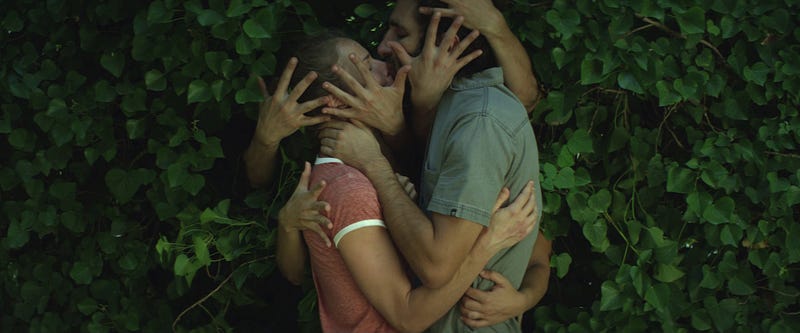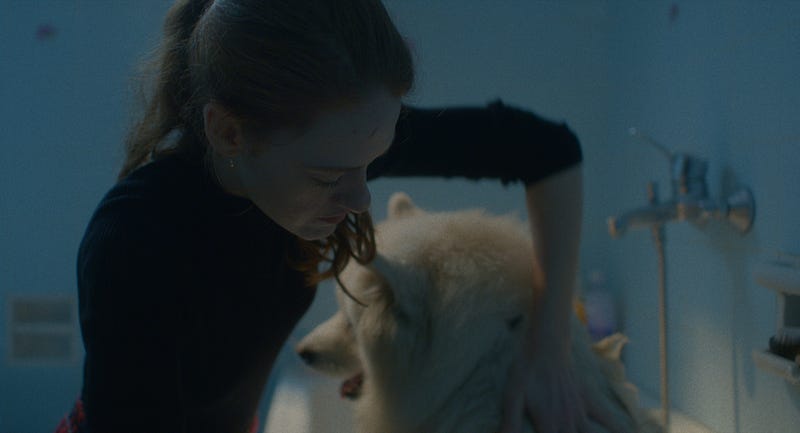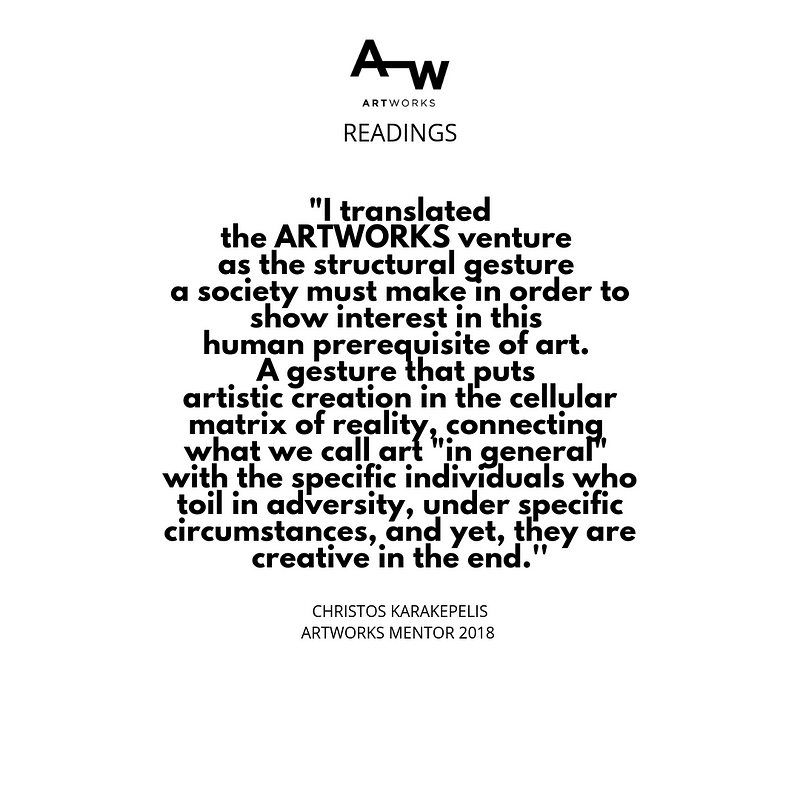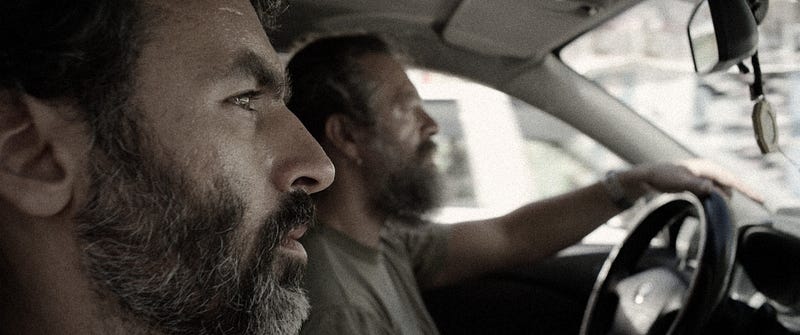03.09.2019
Room to move
Moving image

From 1987 to 2018 it’s 32 long years. At one end is my participation in the ARTWORKS selection panel for the monetary prizes to moving picture artists; at the other, my graduation from Stavrakos Film School as “film director”. Between the two ends, a labyrinthine course for this “artistic” identity to find room to survive as an endemic species among others — a necessity in this complex social food chain. I am talking primarily about room to exist, not room to be accepted, let alone be supported and encouraged.
Eventually, I was able to find and recognise this place not on the way of the young person I once was and needed it but on the way of the person who is now working to make it happen, to supply it to those who need it today. I saw ARTWORKS as an attempt at providing such room, as an attempt for a new layout, an opening up of an expanse within reality where the artistic identity can live. And I was glad to have been able to contribute to this.
I am not sure which science could undertake the examining of the artistic identity in Greek society; not being a scientist myself, I would welcome a paper on the subject. Until then, based on my experience and that of my coevals, I would compare an artist in Greece to Odyssey’s “Nobody”: an unclassified person on the fringe of social give-and-take, a vague entity which cannot be translated in terms of normal life. A romantic at best; at worst, a “pariah”; and in-between one who needs to keep renewing their residence permit in society by submitting the necessary documentation, or else hole up inside themselves and fade to nothingness.

The culture of supporting artists as artists, in view of their special life conditions, was and still is absent in Greece unlike other countries, where state subsidies mirror, if only symbolically, a certain recognition of the merit of artistic processes. Most public funds in Greece are channelled to art foundations and not directly to artists; even on the rare occasions this happens, it is usually linked to a specific project. An artist’s chance of securing a personal subsidy is almost nonexistent, although as a society we exploit to the utmost, financially and ideologically, the art bequeathed to us by History. It may be this abundance of masterpieces and their trouble-free appropriation that makes us forget the human endeavour behind them.
Amidst this chronic deficiency, I translated the ARTWORKS venture as the structural gesture a society must make in order to show interest in this human prerequisite of art. A gesture that puts artistic creation in the cellular matrix of reality, connecting what we call art “in general” with the specific individuals who toil in adversity, under specific circumstances, and yet they are creative in the end. Not less important about this new gesture is that it’s being addressed to young people, so that we get the two poles shaped in synchronicity: a new mindset about cultural policy taking shape at the same time as its subjects, the artists themselves.

What is funded here is not a specific project but the project of the self, of self-determination. What is supported is the artists’ non-negotiable need to be shaped and to survive among us as artists, to introduce themselves as artists and to be able to live as artists. We talk with them and about them, mobilise ourselves for them, take their plans seriously and decide to help them be, not do; be first and foremost, in order for them to go ahead and do.
Without guidelines and specifications as to how they’ll use the money that comes with the prize, free to channel it towards their livelihood or invest it in their education, spend it on research or some project, the young practitioners are credited not just with funds but with the trust that each new generation deserves. Perusing the candidates’ files, I feel having seen the map of this generation, its own destinations and the new media it picks out for this journey — and all this in a rich variety: the range of the candidates’ ages, from 25 to 40, and everything it entails (different levels of experience, different stages in one’s career), ultimately make up a polyphony which we should be able to see in our cinemas, galleries and public spaces as a reflection of what preoccupies, or should preoccupy, our world today.
History shows that art shifts its forms and content at a pace that leaves behind the frameworks (theoretical, institutional, economic) structured around it, and keeps breaking its own codes time and again. Inevitably, all new artists and new works pay the price for this shift, the price of modernity, struggling for the survival of their work and hence for their own survival too. This makes the necessity for support even more crucial for young artists as the key agents of rupture and transition, as the guarantors of renewal. The connection of local elements to the global context, the biopolitical nature of the family, issues of identity, sexuality, desire or political engagement indicative of a society in transition, and new poetic forms (a freer morphology and broadened fields of expression): these are the new traits I saw in motion pictures, the field in which I was specifically involved, and these traits differ a lot from those in the films of earlier periods. It will take a strenuous effort for these languages to conquer the market, find channels to introduce themselves to the public. Yet, if we want an art in synchronicity, organically tied to our life, we have no choice but to support it at the very moment it is born.

Another reason why I think this funding, combined with the freedom to use it at will, is highly significant is the fact that it comes at a time of crushing economic rationalism, when such an almost unconditional gift risks being banished to the sphere of the unreal or beyond the limits of social impertinence.
The historical conjuncture plays its own role and makes this statement even bolder as, amidst an impoverished society, it conveys funds to a seemingly unessential activity: artistic expression. I do not mean to downplay the real importance of the subsidy as a financial aid: an artist’s livelihood has always been a tale of woe, and most artists live in permanent crisis, regardless of the historical conditions. All resources are vital to those not closely or firmly attached to the chain of production. However, it is important to discern the symbolism of social acts and their surplus-value beyond mere numbers.
I think that, if the crisis has any place at all in this assessment, what is most worth discussing is how the programme attempts to synchronize society with its emerging art at this specific moment in time: the fact that it regards as an important goal this synchronicity in the purest area of the social corpus, the one occupied exclusively by young adults. Within a floundering country and despite the collective bemusement, the unprecedented numbness and the unbearable social inertia, the power of young people and the unawareness of the risks it enjoys as a privilege do produce results. All this material could be left to its solitary struggle against chance, as it happened with so many earlier generations, when eventually individuals achieved personal records and broke them too. Here, however, we are talking about the effort to gather a generation around a core of expression, about perceiving culture and creation beyond isolated cases.
From my post I sought out this fresh, current discourse which may be revised later by its own exponents. I looked for this spontaneous desire which tomorrow may be written down as the awkward gesture of a middle-aged practitioner. I searched for the fascination of experimenting which may be rendered obsolete by others in the future. I did not look for something fixed and established but for a move in some direction, for the robust whisper which has yet to be heard in the “here and now”, even though it encompasses it, strangely enough. I am glad to have witnessed an entire mechanism mobilising itself towards a beautiful promise, towards something far from definitive. I hope that this energy becomes an addiction, a second nature to those who gather around it.
Because, the essence of this emerging task is to me the reflection of a sound and clear idea of the culture and the society we wish to live in; an idea that extends, that must extend beyond the conjuncture of the recession in which it was born. We know that even in times of affluence, the arts and the artist remain “lost causes” for our societies. For they keep asking questions on “priorities” which people have always found hard to answer; a philosophical matter with ramifications that we will always be evading. This crisis, and every crisis, will be forever linked to this elusiveness. We won’t resolve it in one go, but it is crucial that we aspire to resolve it. Aspiration is the one right we must not relinquish as a society, especially today when everything and everyone is trying to convince us that we don’t deserve it.
Christos Karakepelis, ARTWORKS Mentor for the 1st SNF Artist Fellowship Program, studied social sciences and film directing. Ηe has directed several documentaries including ‘The House of Cain’ which explores the existential situation of seven ordinary people who have committed murders and ‘Raw Material’, a film that plunges into the most poverty-stricken districts in Athens to discover the invisible link between immigrants’ shantytowns and Greece’s steel industry. He teaches documentary film at the University of Athens and the Stavrakos Film School, and for the past four years he has been directing the annual documentary workshop at Polychoros KET.



